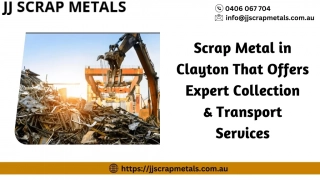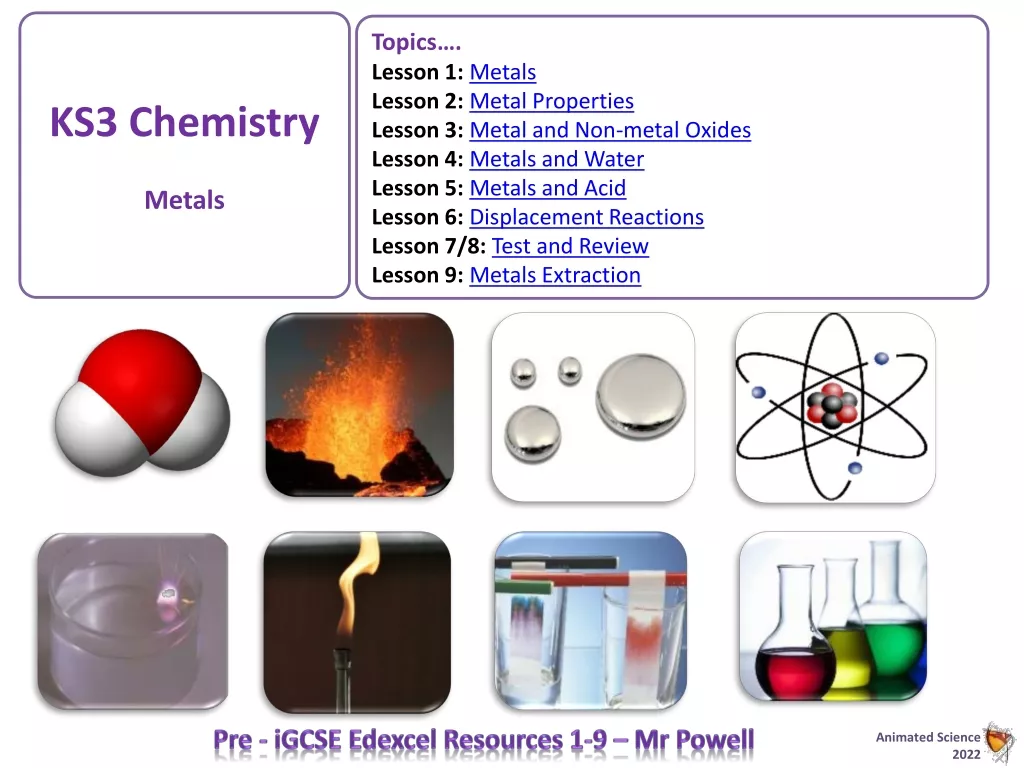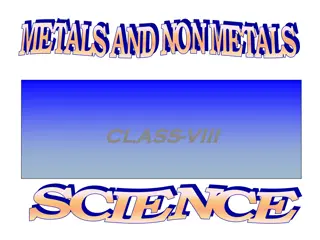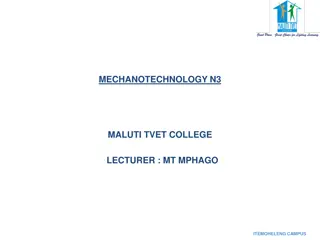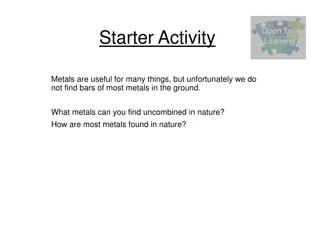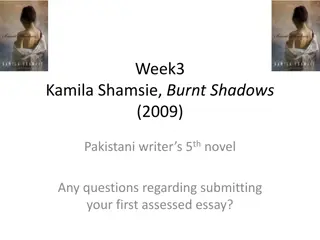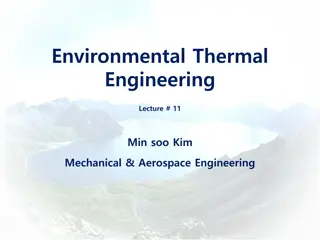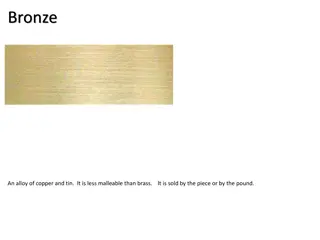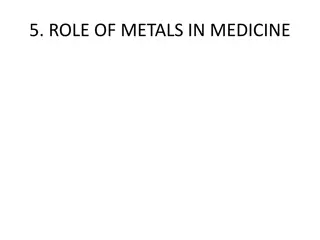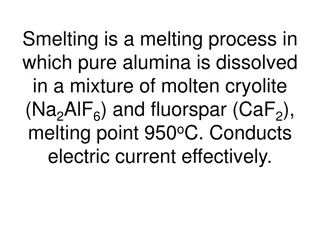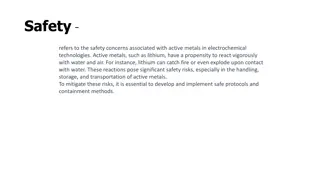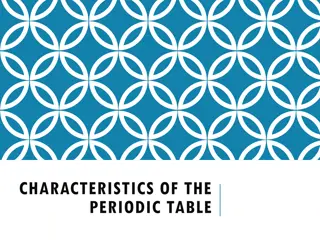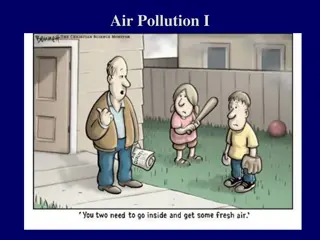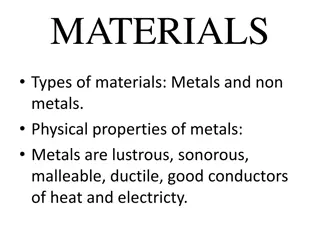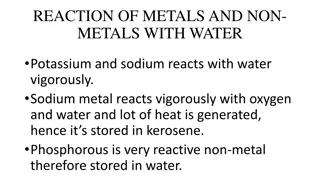
Chemical Reactions of Metals with Oxygen
Discover the fascinating reactions of metals with oxygen in the air through a series of activities and observations. Learn how different metals burn, form oxides, and react with acids and bases. Explore the properties of metal oxides and their behavior in water. Enhance your understanding of metal chemistry with this comprehensive guide.
Download Presentation

Please find below an Image/Link to download the presentation.
The content on the website is provided AS IS for your information and personal use only. It may not be sold, licensed, or shared on other websites without obtaining consent from the author. If you encounter any issues during the download, it is possible that the publisher has removed the file from their server.
You are allowed to download the files provided on this website for personal or commercial use, subject to the condition that they are used lawfully. All files are the property of their respective owners.
The content on the website is provided AS IS for your information and personal use only. It may not be sold, licensed, or shared on other websites without obtaining consent from the author.
E N D
Presentation Transcript
What happens when Metals are burnt in Air?
We know that when Magnesium burns in air with a dazzling white flame. Do all metals react in the same manner? Let us check by performing the following Activity. collect the samples of following metals Aluminium, Copper, Magnesium, Zinc and Sodium. Iron, Lead,
Activity CAUTION: The following activity needs the teacher s assistance. It would be better if students wear eye protection. tongs and try burning over a flame. Repeat with the other metal samples. Collect the product if formed. Let the products and the metal surface cool down. Which metals burn easily? What flame colour did you observe when the metal burnt? How does the metal surface appear after burning? Arrange the metals in the decreasing order of their reactivity towards oxygen. Are the products soluble in water? Hold any of the samples taken above with a pair of
Almost all metals combine with oxygen to form metal oxides. Metal + Oxygen Metal oxide For example, when copper is heated in air, it combines with oxygen to form copper(II) oxide, a black oxide. 2Cu + O2 2CuO (Copper) (Copper(II) oxide) Similarly, aluminium forms aluminium oxide. 4Al + 3O2 2Al2O3 (Aluminium) (Aluminium oxide)
We know that when Copper Oxide react with Acid it forms salt and water We have learnt that metal oxides are basic in nature. But some metal oxides, such as Aluminium oxide, zinc oxide, etc., show both acidic as well as basic behavior. Such metal oxides which react with both acids as well as bases to produce salts and water are known as amphoteric oxides. Aluminium oxide reacts in the following manner with acids and bases Al2O3 + 6HCl 2AlCl3 + 3H2O Al2O3 + 2NaOH NaAlO2 +H2O (Sodium aluminate)
Most metal oxides are insoluble in water but some of these dissolve in water to form alkalis. Sodium oxide and potassium oxide dissolve in water to produce alkalis as follows Na2O(s) + H2O(l) 2NaOH(aq) K2O(s) + H2O(l) 2KOH(aq)
We also know that all metals do not react with oxygen at the same rate. Different metals show different reactivity towards oxygen. Metals such as .. potassium and sodium react so vigorously that they catch fire if kept in the open. Hence, to protect them and to prevent accidental fires, they are kept immersed in kerosene oil. At ordinary temperature, the surfaces of metals such as Magnesium, Aluminium, zinc, lead, etc., are covered with a thin layer of oxide. The protective oxide layer prevents the metal from further oxidation.
Iron does not burn on heating but Iron filings burn vigorously when sprinkled in the flame of the burner. Copper does not burn, but the hot metal is coated with a black coloured layer of copper(II) oxide. Silver and gold do not react with oxygen even at high temperatures.
After performing the above Activity ,we must have observed that . Sodium is the most reactive of the samples of metals taken here. The reaction of magnesium is less vigorous implying that it is not as reactive as sodium. But burning in oxygen does not help us to decide about the reactivity of zinc, iron, copper or lead.
Do you know Anodising It is a process of forming a thick Oxide layer of Aluminium. Aluminium develops a thin Oxide layer when exposed to air. This Aluminium oxide coat makes it resistant to further corrosion. The resistance can be improved further by making the Oxide layer thicker. During anodising, a clean Aluminium article is made the anode and is electrolysed with dilute Sulphuric acid. The Oxygen gas evolved at the anode reacts with Aluminium to make a thicker protective oxide layer. This Oxide layer can be dyed easily to give Aluminium articles an attractive finish.
FOR MORE QUERIES: YOU CAN LOG IN TO WEBSITE www.scienceeasylearning.wordpress.com YOU CAN ALSO LIKE MY FB PAGE THAT IS: KKCHAUHAN https://www.facebook.com/kkchauhanvision/

